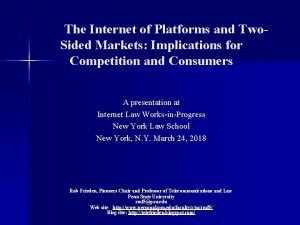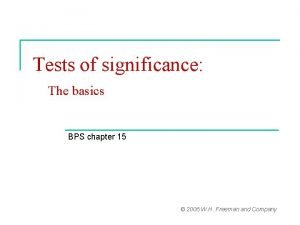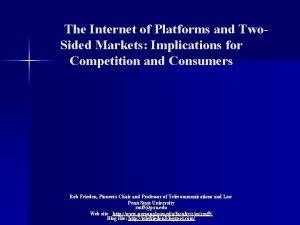The Internet of Platforms and Two Sided Markets















- Slides: 15

The Internet of Platforms and Two. Sided Markets: Implications for Competition and Consumers A presentation at Internet Law Works-in-Progress New York Law School New York, N. Y. March 24, 2018 Rob Frieden, Pioneers Chair and Professor of Telecommunications and Law Penn State University rmf 5@psu. edu Web site : http: //www. personal. psu. edu/faculty/r/m/rmf 5/ Blog site: http: //telefrieden. blogspot. com/

The Main Points Internet platform operators accrue scale and positive network externalities, but also can achieve and sustain “winner take all” market dominance. Do. J, FTC and FCC use flawed market assessments and may impose defective consumer safeguards when intermediaries serve two-sided markets. They emphasize downstream impact without fully investigating upstream effects. Too many false positives and negatives trigger over-regulation and under-regulation. Do. J uses Chicago School economic analysis that primarily considers whether consumers accrue welfare gains; if so, no government intervention necessary. FTC shares jurisdiction with the FCC, but has no industry sector-specific expertise. Emphasis on after the fact investigation of complaints about specific upstream provider/device manufacturer behavior, not carriage issues. FCC has emphasized downstream impact on broadband consumers w/o much consideration of intermediary impact on upstream stakeholders, including advertisers, a free press, employment, risk allocation, central business districts, etc. Governments need to assess the impact of both sides of an intermediary’s operations; consider whether and how lock-in exists and assess market impacts, not simply market share. Smarter oversight needed, not necessarily more regulation and expanded 2 jurisdiction.

Growing Dominance of Internet Platform Intermediaries Internet Service Providers (“ISPs”) operate as intermediaries in a double-sided market with retail, broadband subscribers downstream and other ISPs, content distributors and content creators upstream. The Internet ecosystem supports powerful platform operators who can capture large market share by exploiting scale economies, network externalities and high switching costs/barriers to market entry. Source: STL Partners, http: //www. stlpartners. com/articles/EB_six-key-telco-2 -opportunities_Summary 3

Major Types of Internet Platforms Internet platform operators have evolved from, and adopted tactics of, previous intermediaries such as credit card issuers and broadcasters. 4

Types of Internet Platforms ISPs establish a platform between upstream sources and distributors of content and end users, i. e. , subscribers of “retail” broadband access service. 5 Source: George Ou, Silicon. Angle, https: //siliconangle. com/blog/2010/12/14/division-of-labor-between-broadband-cdn/

Types of Internet Platforms Smartphone operating system packagers, such as Apple and Google, erect a platform for applications available only through an intermediary’s store. 6

Types of Internet Platforms Various specific application and service intermediaries, e. g. , Facebook in social networking, Google in web search; Pay. Pal in electronic payments; Amazon in e-commerce and Uber in automotive transport. Source SEOAgency, http: //www. seoquotes. com. sg/google-display-network/ Source: European Parliament and Business Model Toolboxx, http: //www. europarl. europa. eu/Reg. Data/etudes/BRIE/2016/593510/EPRS_BRI(2016)593510_EN. pdf 7

Consumer Benefits from Two-Sided Markets Digital broadband platform operators can quickly accrue scale economies and efficiency gains by attracting large numbers of users and spreading costs over a global base. Broadband platforms also can generate positive networking externalities, because their overall value to subscribers increases as the number of participants grows. When intermediaries reach a critical mass of popularity, non-users see the advantages in joining the bandwagon which further enhances the comparative attractiveness of a particular platform operator even when other, “multi-homing” options exist. Competitive necessity, more efficient operations & willingness to underprice to acquire shelfspace and market share can result in lower priced products and services, because two sidedplatform operators can calibrate how much to charge each side. Downstream consumers often benefit from intermediary conferred subsidies, e. g. , rebates on top of no-fee credit cards. Free-rider opportunities remain plentiful. 8

Consumer Costs from Two-Sided Markets Consumers may suffer the loss of competition when bricks and mortar, local vendors shut down as well as the broader harms from increased unemployment, reduced incomes and greater risk and uncertainty in the Gig Economy. Consumers may have to pay more for goods and services when platform operators can more accurately assess their price sensitivity through data collection and analytics. Intermediaries can use dynamic pricing to maximize profits; many consumers hate “surge pricing” regardless of its efficiency and offsetting price reductions in off-peak, low demand conditions. Intermediaries defray the cost of subsidies to end users with expansive data analytics that support new revenue streams, e. g. , auctioning advertisement placements. Consumers may not know, or have a sense of the value they permit intermediaries to capture from privacy intrusions through mining consumer behavior, including web site visits and searches, where subscribers use their handsets and the topics of their emails and posts. 9

Subscriber Data Value and Lock-in Cost Missing in the Cost/Benefit Analysis The existence of other service options does not guarantee that market leaders face significant competition and the discipline imposed by multi-homing. Multi-billion dollar unicorn valuations show several “winner take all” industry segments, e. g. , Airbnb, Amazon, Facebook, Google, Netflix, Uber. Positive network externalities favor additional subscribers joining the bandwagon. Massive subscriber populations generate big data that help the unicorns capture the lion’s share of advertising revenue making it possible to fine-tune their data analysis internally and through acquisition of existing, or potential competitors. Many subscribers do not read their service agreements, nor do many understand the scope and value of what they permit intermediaries to acquire, process and sell. AT&T provided a window on such value when it offered reduced surveillance for a monthly $29 payment from wireline broadband subscribers. The company faced significant pushback, but this did not prompt less intrusive data mining, or discounts. 10

Deficiencies in Existing Government Oversight Models--Do. J embraces Chicago School reticence to oppose or demand conditions to mergers, when consumers accrue financial benefits from platform subsidies. What government agency wants to prevent companies like Amazon from foregoing profits and offering lower prices to acquire greater “shelf-space” and dominance? Bear in mind that most economists consider long term “loss leader” pricing unlikely, because of questionable monetary recoupment opportunities. Real potential for false negatives when government oversight is constrained by fealty to libertarian economic doctrine, but also false positives when governments opt for ex ante safeguards that assume likely marketplace distortions. Do. J quite willing to consider high market concentration as evidence of scale and high entry costs rather than lack of competition. 11

Deficiencies in Existing Government Oversight Models--FTC The FTC shares jurisdiction with the FCC and cannot impose data protection and privacy safeguards on common carriers. FTC v. AT&T Mobility (now subject to re-hearing) presents the prospect of even less FTC involvement for ventures that combine, or converge both telecommunications and information services. The FTC’s primary expertise and emphasis lies with upstream content and edge providers, not carriers, however classified for regulatory purposes. Shared jurisdiction with the FCC generates regulatory uncertainty and inconsistency. In light of the FCC reluctance to impose privacy safeguards on carriers, FTC jurisdiction is essential, but not guaranteed. The FCC soon will remove common carrier regulation of ISPs, but unclear what the FTC can and will do going forward. 12

Deficiencies in Existing Government Oversight Models--FCC Political party majority affects whether the FCC embraces ex ante, or ex post regulatory safeguards. Regulatory inconsistency has resulted from the combination of ambiguous and outdated legislation, increased partisanship among the Commissioners, which economic doctrine a majority of the Commissioners embrace and an apparent inability to adjust policies, rules and regulations to account for converging technologies and markets. The FCC concentrates on the potential for harm to downstream consumers and competition with limited consideration of upstream effects, including how platform intermediaries dominate adjacent markets like advertising and news dissemination. Ex ante rules and regulations have the potential to generate false positives for nonexistent, or transitory problems. Ex post remedies may arrive late, or never if a majority of Commissioners consider markets sufficiently competitive and selfregulating. 13

Conclusions and Recommendations Consumers and governments may not fully understand the tradeoffs when digital, broadband intermediaries dominate many market segments including first and last mile content carriage, smartphone and computer operating systems and a variety of content and applications market segments. It has become increasingly clear that consumers have to contribute more value, than what they might infer from widespread promotion of “free” and subsidized access. Last mile carriers, app store vendors and many dominant firms in the Internet ecosystem have mastered the ability to acquire, market and sell subscriber data. To achieve greater clarity on the potential for beneficial and harm impact, courts and government agencies should examine platform operations on both upstream and downstream market sides. See United States v. American Express Company, 838 F. 3 d 179 (2 d Cir. 2016), cert. granted No. 16 -1454. Courts and regulatory agencies also should consider the service options available to digital, broadband subscribers. In some instances, they have ample choices preventing lock-in. However, in other instances consumers have few alternatives, or they incur significant costs, 14 inconvenience, or reduced benefits if they leave the dominant platform.

Conclusions and Recommendations (cont. ) Government agencies need to assess market impacts, rather than simply calculate market share. Convergent markets don’t always fit within a simple vertical/horizontal axis. They also need to consider the inter-relationship between a venture’s successes in combined, or interdependent markets, and whether it triggers new, or greater risks for consumers. Just as platform intermediary operation affects both downstream and upstream users, so too can market success in one market generate unrivaled opportunities to extend market power elsewhere, e. g. , Facebook and Google dominate news dissemination w/o one reporter. Legislators should consider amending laws in light of vastly changed circumstances, e. g. , waiving a prohibition on collective negotiation between newspapers and Facebook/Google. A more holistic examination of impacts, without placing a premium on short term consumer benefits, would generate a more accurate assessment of the mixed impacts generated by platform intermediaries. 15
 Estimate each one-sided or two-sided limit if it exists
Estimate each one-sided or two-sided limit if it exists Dr tulika jain
Dr tulika jain Murmur intensity grading
Murmur intensity grading Right sided vs left sided murmurs
Right sided vs left sided murmurs Types of internet platforms
Types of internet platforms Two platforms
Two platforms 4 corners shape
4 corners shape Two tailed test p value
Two tailed test p value Two sided p value
Two sided p value Two sided p value
Two sided p value Oncology care model participants
Oncology care model participants Four sided shape with two sets of parallel lines
Four sided shape with two sets of parallel lines Two businesses operate in contrasting international markets
Two businesses operate in contrasting international markets Security strategies in windows platforms and applications
Security strategies in windows platforms and applications Security strategies in windows platforms and applications
Security strategies in windows platforms and applications Nature of online platforms and applications
Nature of online platforms and applications





























